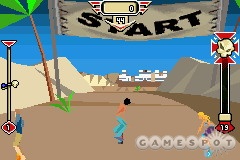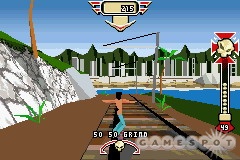Tony Hawk's Downhill Jam introduces a major paradigm shift to the Tony Hawk franchise. Instead of challenging players to string together their best tricks in large, open environments, as previous Tony Hawk's Pro Skater games on the Game Boy Advance have done, this one shifts the focus toward beating opponents to the finish line in a series of enclosed downhill courses. You still have to pull off tricks to satisfy the criteria in certain events, but, by and large, Downhill Jam is more concerned with speed than high-flying acrobatics. As such, it probably won't appeal to longtime fans of the franchise that want to continue flexing their trick-linking abilities, but it might satisfy racing enthusiasts looking for a change of pace.

Right off the bat, anyone that's played SSX Tricky or SSX 3 on their GBA is going to feel a sense of familiarity with Tony Hawk's Downhill Jam. That's because Activision tapped Visual Impact to develop the game, and Visual Impact used the same 3D polygon graphics engine that it used to produce the SSX games for Electronic Arts. In fact, while the courses have moved off the mountain and onto city streets, and the riders are perched atop skateboards now instead of snowboards, everything else in Downhill Jam is roughly the same as it was in the SSX games. Not that that's necessarily a bad thing, considering that when it comes to video games, the concept of racing down a paved hill on a wheeled board isn't all that different from racing down a snowy hill on a waxed board.
Compared to other racing games on the GBA, however, this one holds its own and offers a few twists. Each of the 10 different courses provides plenty of ramps and rails to jump off of and grind on, and you'll notice shortcuts all over the place. Some courses keep you on your toes with rolling hills and sharp turns. Others make you watch out for obstacles like palm trees and fruit stands, or they employ sand and water traps to slow you down. The CPU riders generally stick to their own racing line, and they can't knock you down, so you mainly have to worry about staying ahead of them. It's easy to fall behind the other riders by running into obstacles, but you can kick in a turbo boost when you need to catch up. To get more boost, you need to pick up skull icons littered across the course or perform tricks. That's the main purpose of tricks in Tony Hawk's Downhill Jam: to build your boost meter. As such, the trick system is much less intricate than it is in a traditional Pro Skater game. Basically, you just tap any button to perform a preset trick and use the directional pad to spin.
To finish the game, you have to take first place in the championship event in each location. Knowing the layout of the course is important, but the best way to beat the three other CPU competitors is to upgrade your current board's ratings. You win a new board each time you win a championship. To upgrade a board, however, you need to earn some cash by participating in the trick and challenge events. Each course has three different trick events and three different challenge events. In a trick event, you merely have to reach a predefined score by performing tricks. In a challenge event, you'll be given a variety of goals, which usually include knocking over objects, collecting key items, performing tricks, and finishing the course within a certain time limit. As you can see, they tried to give Downhill Jam some of the old Pro Skater flavor by working various goals into the challenge events. These events really aren't all that engaging, though, because the selection of tricks is minimal and only a few tricks have visual appeal. The true purpose of these events is to draw the game out while you do them over and over again to collect the money necessary to buy board upgrades.

As for the presentation, the audio is forgettable, while the graphics are mostly pleasant. Tony Hawk says his lines for the cutaways, but the actual course audio consists of some cheesy knockoff rock music and a collection of vocal grunts and metallic skate noises. At least the music in the old Pro Skater games was based on popular tracks that people were familiar with. Most people will probably forgive the tepid audio, however, since the graphics are good. If you haven't seen Visual Impact's 3D graphics engine in action before, you're in for a treat. The developer has basically coaxed a Nintendo 64 out of the Game Boy Advance, with some limitations. The polygons aren't texture mapped, for instance. They're all flat shaded. The draw distance is also quite limited, and for some reason you can't turn around and go backward. Otherwise, the system somehow displays a polygonal rider in the middle of a constantly spooling 3D environment, and it lets you interact with just about everything in those environments, either when you crash into obstacles or jump and grind off of them. Characters' movements and tricks generally look fluid, although the frame rate does hiccup here and there. Obviously, the low polygon 3D employed here can't hold a candle to what the Nintendo DS and PSP are capable of, but it's pretty impressive to see on a Game Boy Advance.
Ultimately, the main thing to keep in mind is that Tony Hawk's Downhill Jam isn't a skateboarding game. It's really a racing game. If you're in to racing games, you might like it, especially since the ability to perform tricks isn't something you're able to do in most racing games. Conversely, if you're looking for the next trick-heavy Tony Hawk, you should probably look elsewhere.